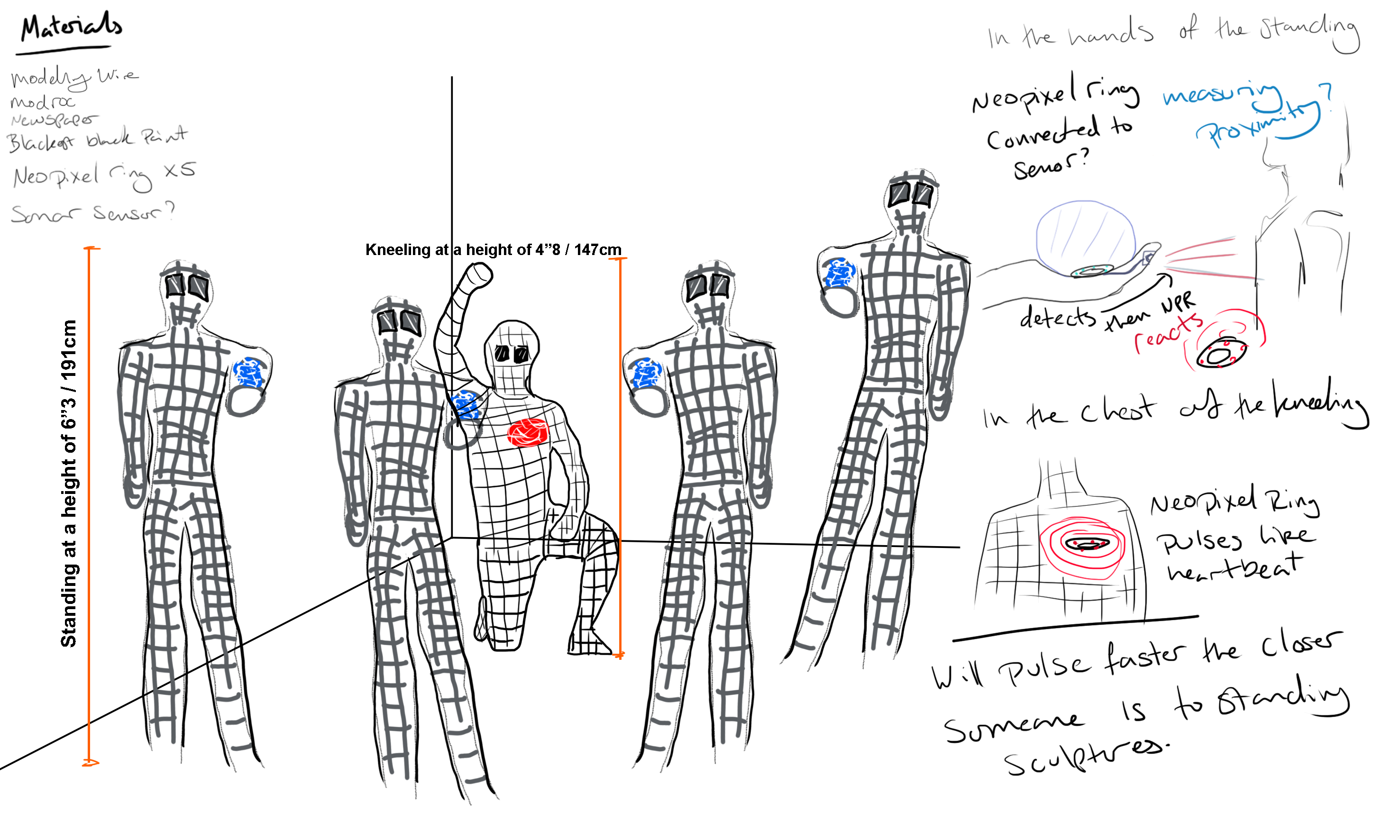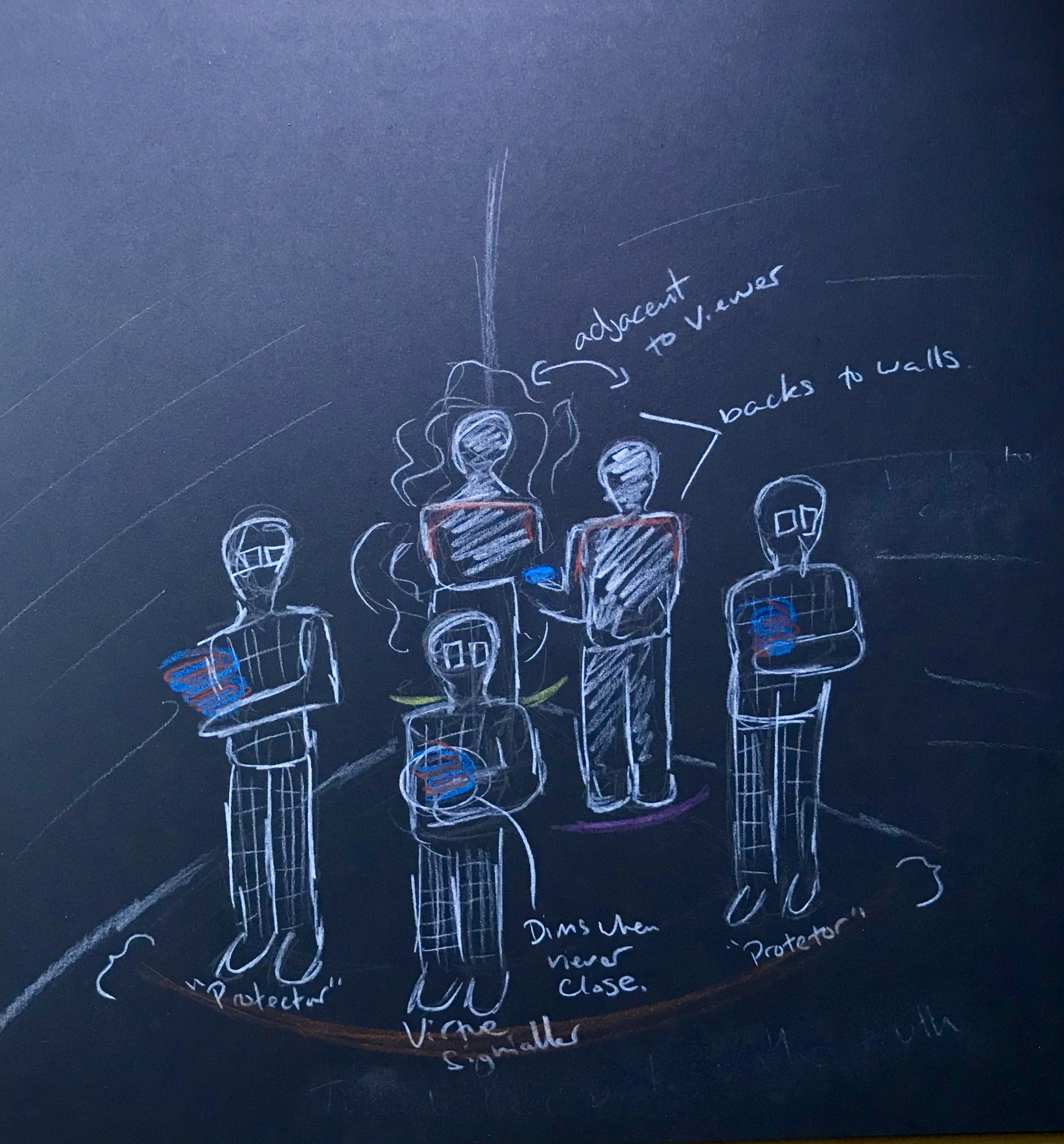HERE I Stand
Multimedia installation: sculpted embodiments of plaster on wired armature, augmented with sensor-controlled LED lighting
Produced by: JG Legion
Introduction
Here I Stand is an installation that began as an embodiment of the visual conversation that takes place when one person encounters another. Initially developing against the background of the BLM protests, as part of the debate about whether we can ever really see each other, the work took a new direction after the appearance of the pandemic, with all its implications for our patterns of behaviour. It rapidly evolved into a more highly charged, deeply personal consideration of the question of human interactions.
Concept and background research
This installation depicts my view of the events of the past few months. It features four sculptures, each standing at 6’ 3” and representing a level of the conversation.
I intended it as a (literally) standalone work, and as far as possible, self-explanatory. How much, if anything, people take away from it is irrelevant. My intention is one thing and the audience’s interpretation is another. The key point is that I did not want to spoon feed the audience. If they are unable to decipher the meaning, that simply reflects the real and difficult nature of the conversations surrounding race.
The appearance of the pandemic added another layer, throwing an even sharper focus on the hypervigilance that some of us have long been aware of.
I always intended this to be a mainly physical piece, because of what it represents, but the impact of the pandemic on how we all relate to each other in any physical space made this imperative.
But it was also essential for it to be both physical and virtual. I deliberately chose not to make it interactive online as that would add to the negative connotations of virtue signalling contained in the work. I did not want this to become just another gimmick, another thing to play with then drop, never fully understanding the depth of meaning in the piece.
It’s all to do with the way we view the world. Virtuality means you can go to places you never thought possible, but are you really there? No, but you can see things that you wouldn’t have before the appearance of the internet. I couldn’t physically join the BLM protests, but I joined them online. I was there but I wasn’t.
People have viewed my work online, does that mean they’ve seen it? What does it mean for someone to view a sculpture on a screen? They don’t get to participate and engage in the same way as they would in physical space. They see the filtered version, the Instagram-worthy shots, the polarising distance from the truth. They won’t see what people in the room will see, when they share that physical space with the work.
This also speaks to the question I asked the audience in a previous work: “Where do you see yourself in my art?” This is why I am unwilling to spoon feed anyone with explanations of my intent. I want people to think, to look outside themselves, to see what I see.
I planned the piece as four figures, each embodying a type and each with a specific colour of light. The lights were sensor-controlled to trigger when someone stood too close to the figure with the colours representing certain aspects of the type. Distance and proximity were the keys to these interactions.
The ignorant protector has to get their opinions in fast and hard, without the foresight to listen to the people they claim to speak for. Weighed down by their inability to understand, they are driven to their knees when confronted with the realities of the conversation.
Greeny blue is the colour of ignorance. Red mixed with yellowy white is the colour for hypervigilance and raised awareness. The colour of our Covid-aware reactions. Step too close and you will not see the truth. You must learn to step back and read the space. All the information you need is here, if you look in the right direction.
The virtue signaller is a twisting, spineless manipulator. Always wanting to look like they're doing the right thing, they make a great show of their (meaningless) actions.
Yellow is the colour for the virtue signallers. Cowards.
The supporter is ready for the hard conversations, ready to be there, listening to the unheard. Ready to learn. Willing to accept their responsibility to offer a helping hand when most have turned their backs on the unheard. Although none of us will ever have a true understanding of one another, the conversation between the supporter and the cornered keeps alive the hope that there is room to grow and learn.
Blue with flakes of green is the colour for the supporters. Blue is the colour of understanding, and they are examples of how these conversations could and should play out.
The cornered has lost all faith in human nature, their colour worn away by the torment of oppression. They are exhausted by endlessly trying to continue the conversation about their identity. There are so many others who wish to silence them, but they are driven by the desire for much deeper conversations than most ever dream of having. A conversation that was already almost beyond reach, now complicated even further by the urgent need for physical distancing.
Because they have lost that fight, the colour has drained from them, for as strong as they are to still be standing despite the weight of their oppressors, their blue light has drained to white.
The title of the work, Here I Stand, has a long history. It refers back to words supposed to have been spoken by Martin Luther in 1521, when he defended his radical ideas about religious reform. Cited by many others since then, it was also the title of a 1958 memoir and manifesto by civil rights activist, singer and actor Paul Robeson, the son of a slave and an outspoken critic of racism in the United States, who was blacklisted (but never silenced) by the House Committee on Un-American Activities.
Robeson said: “The artist must elect to fight for freedom or for slavery…”
Representation of the human figure is a key concept in the work of Antony Gormley, and a key influence on my own practice. I am particularly interested in his views on the importance of context and physicality in an increasingly virtual world, again made more relevant by our current situation:
“This is a place ... that I would like you to ... look at differently because of this event that has happened in it ... it just asks us to look again at this world, so different from the world we have been sharing with each other and the technological world, to look again at the elemental world. The elemental world that we all live in is that space that we all visited together, the darkness of the body. I wanted to start again with that environment, the infinite subjective space that each of us lives in.” (Gormley, 2012)
Surrealism has been another strand of influence in my work, and in this case, I was struck by the importance of chance actions and events, for example in the randomness of Dadaism, and how they can have unexpected effects, as they did in this work.
Technical
I was very deliberate with the choice of technologies I used in this piece. First, it was important that the figures had a physical presence, that they took up space in the room. This was an essential part of the interaction between the audience and the work.
I chose to sculpt the figures in plaster on an armature to give them that presence, but I also deliberately made them in a non-solid form, because their internal reactions to the proximity of others were another key aspect.
I painted the figures in Blackest Black, for reasons that require no explanation.
It was equally important to continue that physicality in the neopixel rings and ultrasonic sonar sensors, tools to provide the means of demonstrating the confrontation the audience has to face when viewing this piece.
This was a complex work, and one major challenge was the lack of access to studio space - I made the figures and worked on the electronics in my room at home. That meant having to find work-arounds for some aspects, and having to make compromises on others. For example, the piece was planned as a larger installation, but I scaled it down because of the limited space I was working in.
It also involved some complicated logistics in transporting the sculptures to the venue. When I had the work in place there, I had to adapt my original plan for the positioning of the figures, to make best use of the space and the environment.
Although this was quite challenging, the end result was actually more dynamic and engaging than I expected.
Future development and Self evaluation
This piece was always going to have a finite life, because it was time-sensitive and site-specific. I am looking ahead and thinking about new areas of research, in particular considering ways of adding new layers of meaning. I also plan to develop my use of light and colour, and explore the potential of augmenting this with sound.
On the whole and considering the many unexpected problems thrown up by the pandemic, I was satisfied with the end result in Here I Stand. Most of the glitches were fairly minor and could be worked around. For example, I planned for all of the figures to be standing, but one was damaged in transit, so I adapted it to kneel on the floor instead.
The electronics also needed some adaptation, and another time, I would definitely build in a longer set-up to allow for wiring up and checking the sensors and lights.
Given my interest in Surrealism, an unexpected but intriguing aspect to the work was that it appeared in the show unlabelled. I was for a moment concerned about this mishap, but I realised it added a brilliantly Dadaist sense of randomness, absurd and provocative.
The missing label (you can see it here) would have asked people to “Look, see, think. And remember.” I was trying to make a suggestion, not an instruction. But the lack of information gave people the chance to have an unfiltered interaction with the work.
In some ways, though, audience response is not the relevant question here. I wanted to have my say, to state my case, and Here I Stand certainly achieved that.
References
Here I Stand. Paul Robeson and Lloyd L Brown. 1958, Beacon Press, Boston
Gormley, A 2012, Sculptured Space within and without, online video, TED, viewed 23rd September 2020, https://www.ted.com/talks/antony_gormley_sculpted_space_within_and_without

































































